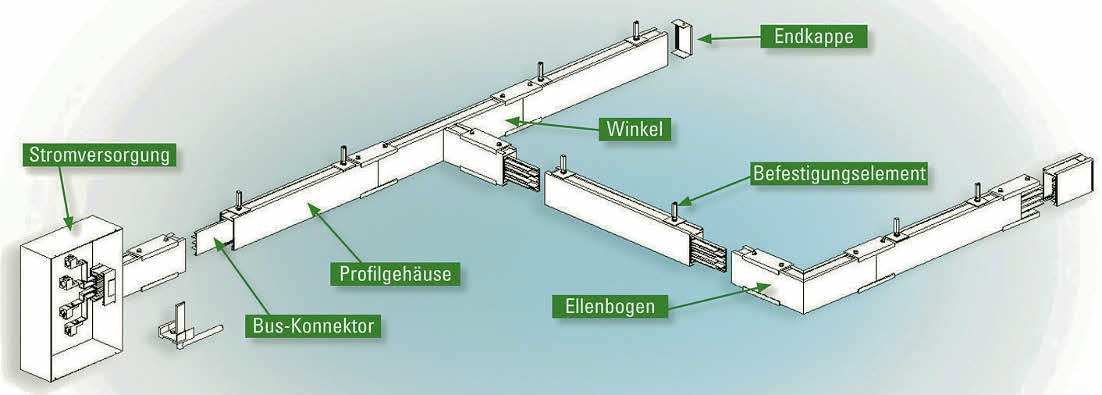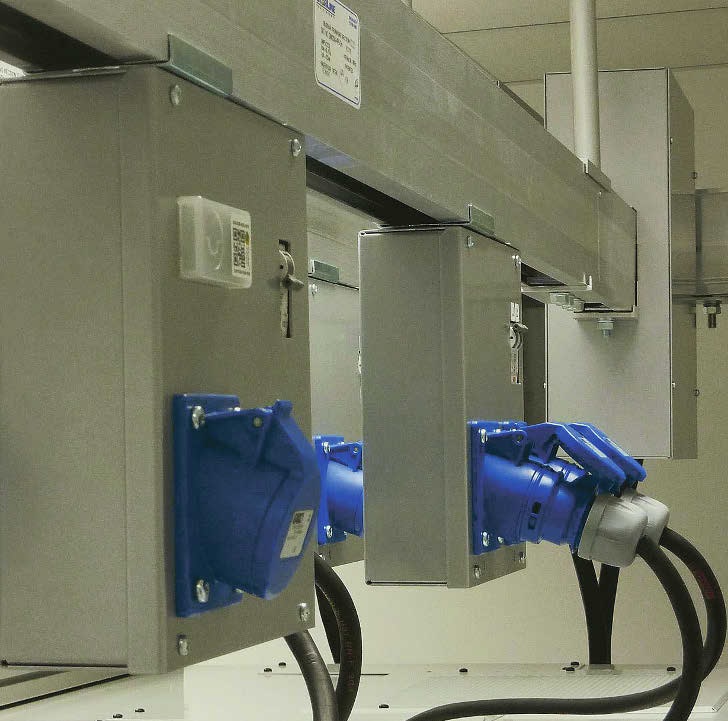Cable or rail? Planning a data center infrastructure
Whenever planning a new data center infrastructure to be set up or expanded, the question arises as to how the spatial power distribution can be managed in the most reliable, cost-efficient and secure way.

In the past, most data center operators opted for a cable-based solution installed via trunking on the data center ceiling or in the raised floor, from where it supplied power to the hardware in the racks via PDU (power distribution unit) cables. Strictly speaking, no decision was then made, but for lack of technical alternatives, the standard solution route with the cable lines was taken. Systems for power distribution by rail were already represented on the market in isolated cases, but these solutions, originally intended only for use in industrial environments, still had various handicaps at that time: For example, the outgoing boxes on the busbars were so generously dimensioned that they could be easily accommodated in production halls ten or even 15 meters high, but were hardly suitable for use in data centers with low ceilings, densely packed racks and raised floors. The screwed connection points between the individual power strips also caused problems. When the temperature fluctuated above the cold or hot aisle, the connectors loosened or even came loose completely. To fix this, it was necessary to disconnect the power supply - which, of course, was not a good idea when powering racks running production servers.
In addition, setting up each outgoing feeder box, for example to supply power to a newly added rack, required sufficient planning lead time as well as calculated downtime for the deployment of an electrician. Today, rail-based power distribution systems designed specifically for use in the data center not only represent a genuine alternative to cabling solutions, but are actually superior to them in terms of cost-effectiveness, user-friendliness and flexibility.

The principle of operation of busbar trunking systems
In a solution called Starline, for example, power is distributed by rail via modular, expandable rail profiles that are fastened to the building ceiling or in the raised floor. The individual aluminum profiles are connected to each other via screw- and bolt-free connectors, which are dimensioned in terms of length to ensure optimum heat dissipation, thus ruling out any loosening or even loosening of the connecting elements due to temperature. The power supply itself takes place at just one central point and supplies the entire rail system with currents of 100, 225, 250, 400 or 800 amperes, depending on requirements, and with a voltage of up to 415 volts.
Wherever power is required in an IT environment, for example at any server rack, an outgoing feeder box can be easily fitted into the rail profile as a distribution unit. The installation is done in just two steps, namely by inserting the coupling of the outgoing box into the housing of the rail profile and a final 90-degree turn. - This simple procedure should be familiar to anyone who has ever worked with Fischertechnik building blocks. Single-phase or three-phase power connections are then available above the feeder boxes, via which cabinet PDU power strips can be connected, by means of which all the hardware in a rack can be supplied with power.
Power supply to racks via outgoing boxes or cable
The outlet boxes can be mounted anywhere along the Starline busbar, which proves to be a significant advantage over cable panels, as these can only be mounted at predefined fixed points and at a constant distance from each other. Accordingly, the positioning of the racks in the cable-based solutions is based on the specifications of the power infrastructure. This circumstance naturally leads to losses in terms of the positioning options for racks and their density, as well as in terms of expansions, dismantling and the overall flexibility of an IT environment. Even more crucial, however, is the fact that the installation of new feeder boxes for busbar trunking systems takes only minutes and not weeks as is the case with cable systems. This huge difference in time is not due solely to the fact that it typically takes an electrician one to two days to create a cable junction. Most of the time is taken up by the planning phase: Because in order to create a branch for a cabinet PDU, the entire power supply to the racks fed via the corresponding cable panel must be interrupted as planned downtime and then slowly restarted. This is where the rail systems come up trumps, as an expansion with additional outgoing boxes can be carried out simply by plugging into the rail and turning 90 degrees while the power supply is running and thus at any time.

Performance comparison in high-density and mission-critical data center environments
Further advantages of a power supply via rail can be seen in particular in mission-critical sectors such as development and test environments. These often suffer from cramped spatial conditions in which all the IT equipment is densely packed. In addition, systems are often reconfigured and repurposed, and entire racks are moved to replicate "real-world" IT scenarios where development and testing takes place under live conditions. Cable panels can't keep up with the required configuration pace here, neither structurally nor in terms of technical design, because, as already mentioned, they are limited in terms of the number of available cabinet PDUs and tied to fixed branch markers. In addition, the time required to set up a cabinet PDU in a new location is always the same as the length of the planned downtime. And installation times of up to a week are an absolute knock-out criterion, especially for internationally positioned companies that develop and research around the clock according to the "follow-the-sun" principle.
Therefore, the use of a rail system in such areas is recommended not only because of the option of being able to add and also move outgoing boxes in minutes without interrupting the power supply: Outlet boxes are usually designed in such a way that one unit provides several outlets for connecting cabinet PDUs at the same time, which correspondingly also supplies power to several racks at the same time. In this way, for example in densely populated test or demo environments, on the one hand the racks can be supplied with ampere rates of 16, 20, 32 or 63, and on the other hand 230 VAC devices can be supplied with power at the same time. To ensure that the power distribution is not only flexible and variable, but also protected, the feeder boxes usually have circuit breakers and multiple physical protection. Redundancy in the entire power distribution infrastructure, which is obligatory especially in the mission-critical sector, can be easily established by a second rail system running parallel to the main rail.
Costs and efficiency
When considering the costs of both power distribution systems, the cable-panel solutions initially score points with regard to the pure material costs for an initial installation. This is because, quite profanely, cables are naturally cheaper than aluminum profiles. The rail systems make up for this advantage and overtake the cable panels as soon as the costs for setting up a power infrastructure, including the branches for the cabinet PDUs and their operation and maintenance for a period of one year, are taken into account: Depending on the size and complexity of the power distribution, rail systems incur between 30 and 50 percent less installation and maintenance costs than conventional cable solutions. The cost advantage of rail solutions is also gradually increased with each expansion. These potential savings result in an estimated TCO (total cost of ownership) advantage of 20 to 30 percent over cable systems in the medium to long term. This advantage can be even higher if the long service life and reusability of the rail systems are taken into account - and secondary positive cost effects that arise, for example, from the elimination of meter-thick cable harnesses in the raised floor and an associated optimization of the cooling air flow and cold air pressure, as well as an ultimate increase in overall cooling efficiency.
Conclusion
Today, power distribution in the data center by rail is not only a real alternative to cable-based systems, but has also become a solution of first choice due to the technological and functional advantages outlined. And the special highlight is: the value and efficiency of a rail power distribution system can be further increased by a complementary solution for energy monitoring. Integrated from the outset into feeder boxes or end feeders of a busbar trunking system, or even retrofitted, radio-based measurement modules capture vital current values at the spatial distribution level, such as volts, amps, watts, power consumption, frequency, power factor, apparent power or consumption peaks, and make them available to data center or facility experts via local display, dedicated user interface or third-party DCIM or BMS application. Not only can power be safely and reliably distributed over the rail, but data center professionals have the tools they need to optimally distribute loads, manage consumption more efficiently, save energy, and protect their data center from power-related system failures.









